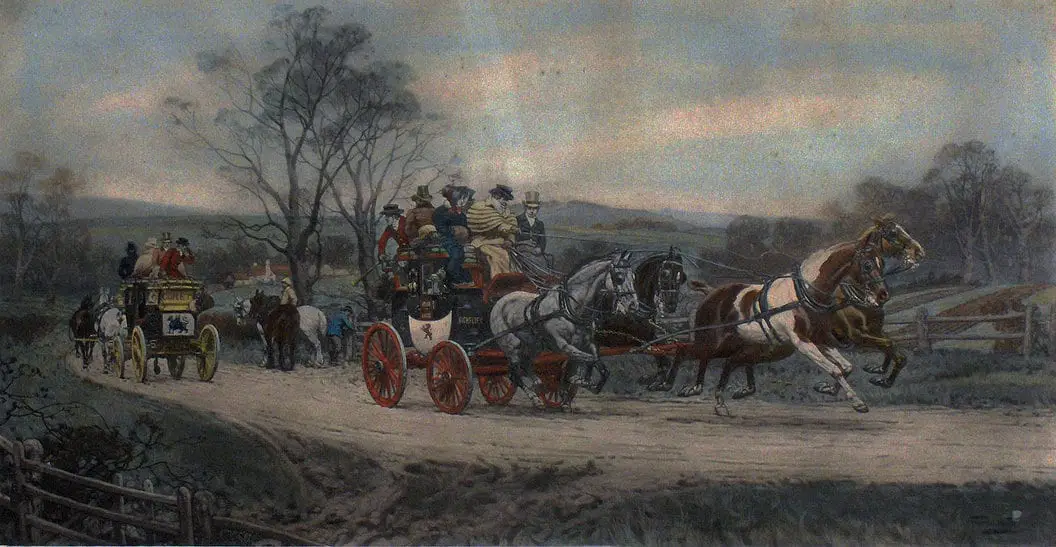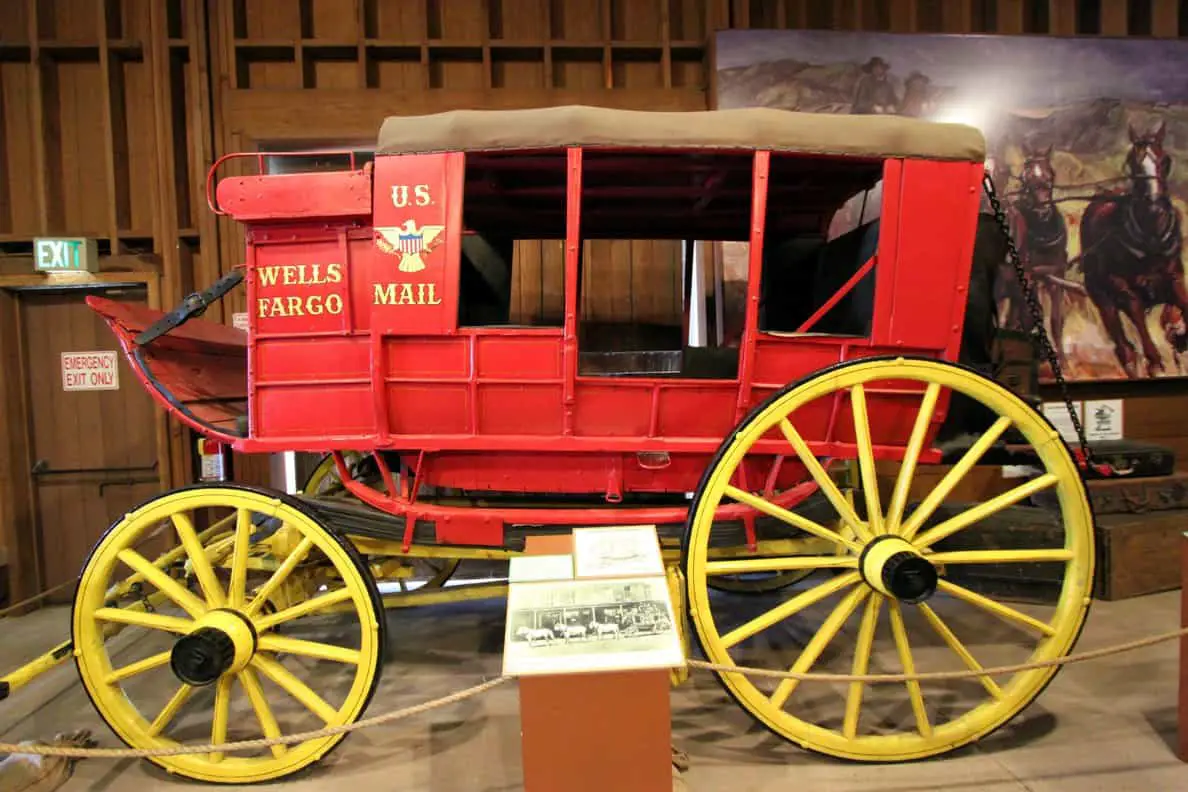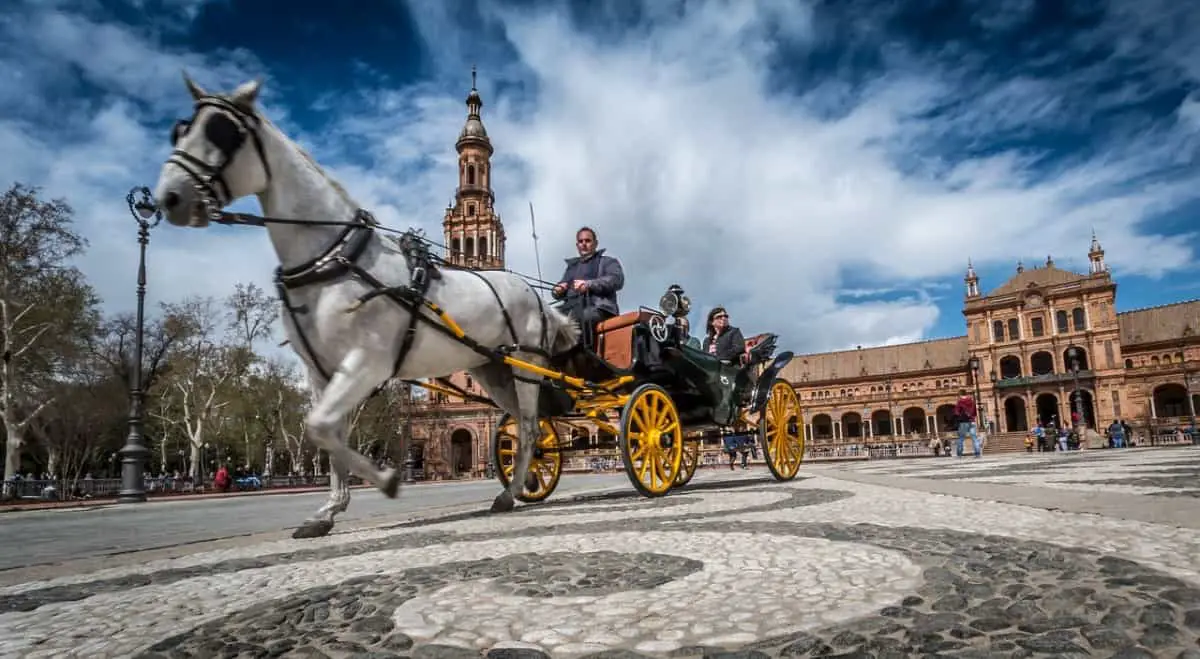Anyone who has watched Western movies or TV shows almost certainly remembers a scene with a runaway stagecoach. The hero needs to crawl out of the stagecoach window, drawing himself up to where the driver sits, hoping to pull multiple horses at full sprint back under control.
This brings up a great question: just how fast could a stagecoach go? While the theoretical top speed will be much different than any practical top speed, we can make a good educational guess on the speed of a stagecoach.
It is well established that the average speed of a stagecoach was approximately four to five miles per hour with a single group of horses depending on the route. On a well-maintained road with stations to bring in fresh horses a stage coach could go twice as fast at up to 10 miles per hour on average.

These were speeds from real life, which are better answers than horses on a modern track of purely flat land, since finding that in real life isn’t likely. Top speeds could be a bit higher, but we can figure out a range of what those are likely to be based on some numbers.
We dive into all of those numbers a little bit further below.
Table of Contents
What’s the Fastest A Stagecoach Could Go?
While we can’t get to an exact mph number, we can get some pretty good estimates based on the information available.
This depends on whether the stagecoach is going a long distance over open country with the same set of horses or traveling a well maintained road with established posts to trade tired horses for fresh ones.
The flatter the terrain, the better the path/road/trail, and the better shape the horses, the faster a stagecoach could go. Keep in mind that this would be dragging a heavy stage coach, the weight of any passengers (not to mention a driver or shotgunner) and supplies and gear being carried.
There’s also the difference between short-term and long-term. In modern times no one has really tested making four horses sprint full speed while pulling a stage coach while holding a stop watch. They might be able to sprint for a short distance, but they’re not going to be able to keep that up over a long distance trip.
There’s also one more important factor that matters: gravity and balance. What’s that mean? Stagecoaches can tip over. Hit a bump wrong, turn too fast, and the momentum will do the rest.
There’s a reason no one really knows the absolute full speed of a stagecoach: because it is dangerous to find out!
That being said, here are some numbers worth considering:
- A horse walks at 2-4 mph
- They trot at 4-10 mph
- Horses canter 10-20 mph
- A full gallup (sprint) is 25 mph on average (some slightly less some slightly more)
That is just a horse with no weight, no rider, and not pulling a stagecoach. For a small horse drawn carriage some really good speed could be achieved for small sprints. For example: a small sprint of 20 minutes on a very good road on flat land could reach 15 mph. Which would get you a 5 mile distance before they would need a minimum of a 15 minute walking break, according to this answer on Quora.
So that would average out to about 10.5 mph because you would get two sprints of 5 miles each and 20 minutes of walking in an hour. That’s with a carriage designed to be light with only two adults.
So 15 mph at top. A stagecoach would have more horses, but also be pulling more weight. It’s reasonable to assume their top speed even at sprint would be a bit slower on average, or around the same level, tops.
How Fast Does a Stagecoach Actually Go?
This is a question we have plenty of data on since the historical records of stage coach routes still exist. In fact, many are quite easy to get a hold of! Since stagecoaches were generally used for long-distance travel it makes sense to measure speed by how quickly a long trek could be completed.
From the UK in the 1830s an exceptional time from Bristol to London (119 hours) when the weather was good could make the trip in 17 hours. There would be several stops to switch out horses along the way but that means with this technique an actual travel speed of 7 mph was possible, according to History Extra.
The number you generally see as an average for stagecoaches in the U.S. history books if 5 mph. If traveling through mud, in steep hills, or with other issues that the time could take a hit but over a long journey the average would come out to about 5 miles every hour.
In Europe monasteries, forts, and even hamlets with an inn tended to be spaced about 40 miles apart as this was a common distance that could be traveled by stagecoach in a day with one team of horses before putting up for the night.
Why the Difference in Speed?
There are many different reasons for this. One is that when transporting people comfort matters way more than top speed. Especially if comfort comes at the expense of speed.
Keep in mind that in real life scenarios there are concerns about the terrain, about the comfort of passengers, about materials being properly held down, and about the long-term health of the animals.
An average speed would be a good higher end speed that finds that sweet spot that allows traveling all day. That’s where the 5 mph number often comes into play. Wagon trains going west in U.S. history often made closer to 4-4.5 mph but that was because of a lack of trail, difficult terrain, and other environmental factors as they traveled.
Horses can walk or clop slowly for very long times or they can run fast for very short times. That’s it. So even if they could sprint for a top-notch speed for a bit, that is a very short term thing. That’s a major reason why major roads in European nations that messengers used, or services like the Pony Express in the United States had stations to switch out horses every 5-25 miles.
Stagecoachs Vs. Carriages
There is some overlap between these two methods of horse, oxen, or donkey based conveyance. Generally speaking stagecoaches can be considered a type of carriage but not all carriages are stagecoaches.
Carriages can be an accurate turn for almost any wheeled wagon used for transporting people versus goods. In modern times these are often private or hired at tourist destinations. Classic modern example: hiring a carriage ride through New York City’s Central Park.
A stagecoach is a specific type of carriage. Always enclosed, always four wheels (no two wheel options here) that were used to carry both passengers as well as goods. These were used for transporting mail, money, as well as travelers’ and their possessions in the early days out West.
These were both used. Carriages were often more common for short distance travel in the cities although there were also private carriages in some countries and territories that wealthy travelers might use to travel from an estate to a town or city.
When the horses got tired, there were stations along the routes where they could be replaced with fresh horses, as part of the service. It was the long distance bus trip of the past.

A stagecoach differs from a carriage in a few different ways. More specifically, the stagecoach is a very specific type of carriage.
A stagecoach is going to be a carriage that is always enclosed, tends to be larger and heavier, and was used to transport both people & goods. These would be most often pulled by teams of horses, though sometimes mules might be used.
The routes were often overland, on a regular schedule, and could cover very long distances. Horses would often be changed out along longer journeys and there would be set stops along the way that included inn-style housing or bunks.
That’s actually where the name “stagecoach” comes from. The coach used to take passengers and goods stage by stage through a long distance journey. (Take a look at this old stagecoach advertisement for a really interesting read).
One interesting side note: there were lighter and simpler versions of a regular stage coach that was specifically used for territories that commonly had very rough ground. These were nicknamed “mud coach” and would not go as fast but were better designed to get through mud and rough terrain than the heavier and bulkier regular stagecoach.

Carriages are any type of wagon that would be pulled with people. This includes stagecoaches, it includes simpler designs like the one above, and even those two wheel carriages you sometimes see.
Carriages can be open or closed, the number of passengers can vary from one to another, and the designs can frankly differ quite a lot. Some carriages need as little as one horse to pull it while larger designs might need six.
Carriages are also generally used as needed. They are not set to a schedule the way stagecoaches are. There are racing carriages, which would be able to move faster than your average stagecoach.
In Conclusion
While there are definitely some differences between carriages and stagecoaches, this article has pulled together all the best resources to try and answer your questions. While those scenes in old Westerns are exciting, the truth is the fastest speeds wouldn’t be something that would seem all that special in today’s day and age.
Mind you, falling off a moving object can hurt like bloody heck at “low” speeds like 15 or 20 mph, and you never want to get run over or trampled by a horse, but it’s safe to say that while stage coaches are an indelible part of the Old West lore, there’s a reason they generally went the way of the dodo when faster transportation was invented.
